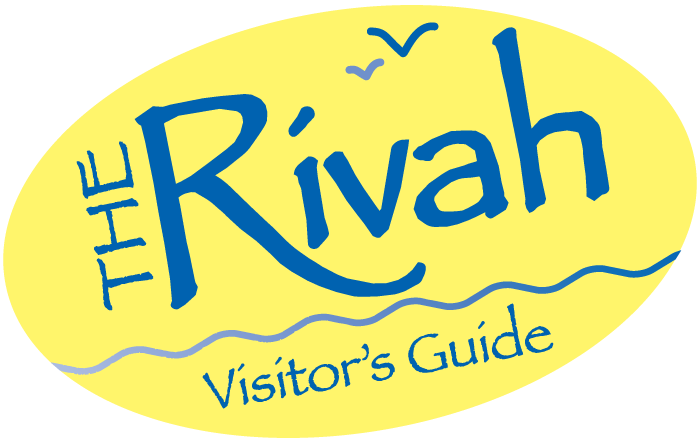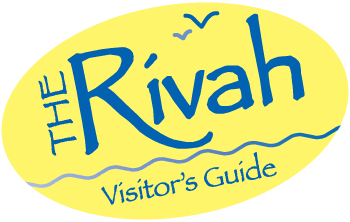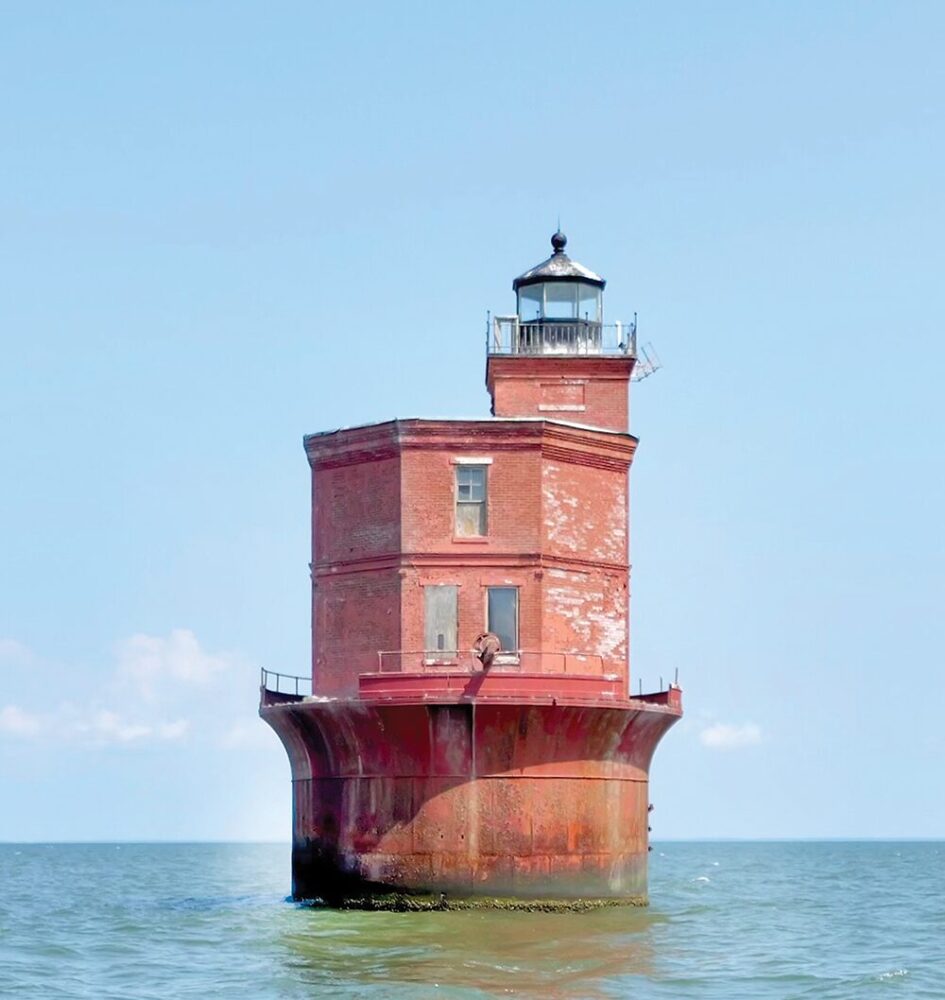
Wolf Trap Lighthouse has stood for 130 years, guiding Chesapeake Bay mariners around the shoal three miles off Mathews County.
Replaced by technology of a flashing light on a pole, it has been forgotten — almost. Wolf Trap Lighthouse is entering a phase that will see it returned to its former majesty and once more become a beacon for the Chesapeake Bay, says Rich Cucé, the brains behind a bold plan to restore the lighthouse built in 1894.
Cucé bought Wolf Trap Lighthouse sight unseen in spring of 2023. In fact, he bought two other historic lighthouses sight unseen — Hooper Island Lighthouse in Maryland, purchased through a government auction in 2022, and in 2024 the Craighill Channel Lower Range Front Light, built in 1873 near the entrance to Baltimore Harbor.
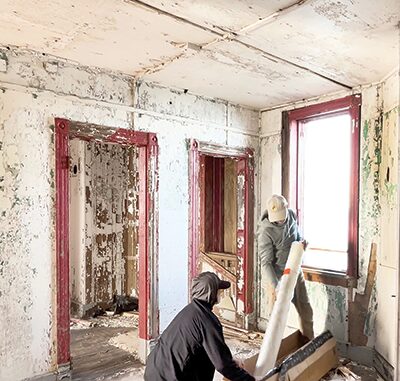
“I had seen pictures of their outsides so I knew that they weren’t falling down,” he recalled. “afraid that if I saw the inside I would talk myself out of buying them. I definitely had some sleepless nights, wondering what I had gotten myself into. I still have those!”
The lighthouses were really rough on the inside, he said. Some windows and doors were missing. Water had gotten in and rotted the floors in places. They were filled with trash, peeling paint, feathers and even some dead birds. “But when I looked past that, I saw that they are mostly solid and there is no damage that is not fixable,” said Cucé.
Cucé, (pronounced Ku-chay´) formed The Lighthouse Centers (TLC) for Technology, History and the Environment with a mission to restore these iconic offshore lighthouses and repurpose them as a network of educational, environmental centers where people can learn about the history, see the technology we use to produce off-grid energy, and get inspired to help improve the Chesapeake Bay, he explained.
Ravages of time
Against the power of water and wind, Cucé is reversing the ravages of time. Others had tried to restore all three of the lighthouses, but eventually gave up. The challenges ahead are daunting, but when divided into phases, the steps to success seem clear. “This project is an emotional rollercoaster. It’s either frustrating and dangerous or peaceful and satisfying. But it’s always expensive!”
The foundation of Wolf Trap Lighthouse is a caisson — a one-inch thick iron shell filled with more than five million pounds of concrete. The caisson is in 18 feet of water and extends 13 feet into the bay floor.
He and his son, Thomas Cucé, made a YouTube video of their first time on Wolf Trap Lighthouse that went viral, getting more than 3.5 million views!
“Most people thought it looked absolutely terrible inside and out. But I am kind of an optimist so I didn’t think it was so bad and that got a lot of laughs. Some people commented that I am dumb or crazy or that it was a huge waste of money.”
Forward
Plaster or drywall was not used in these offshore lighthouses. All have brick, metal, or solid wood walls and ceilings, so they held up to moisture pretty well.
There’s a saying, “If your dreams don’t scare you, they’re not big enough.” Cucé said his dreams are big enough to elicit doubts. “I have thought about giving up, because it’s an exhausting amount of work and incredibly expensive but I’m so invested now and so many people are watching that there is no way I will stop until these lighthouses are restored and being used for their new purpose as offshore historical and educational centers. As far as I know, no one has ever done anything like this.”
Work ethic
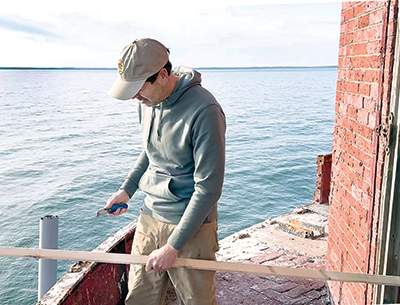
Cucé is no stranger to hard work. His father immigrated from Italy in the 1960s and started a landscaping business where Cucé started working when he was 9 years old. In 1994 at the age of 22 he started Blastco, an industrial blast cleaning and painting business near Allentown, Pennsylvania.
Cucé, now 53, has taken on the biggest challenge of his life, restoring three lighthouses. “My sons help me run the business and help with the lighthouse restorations as well. We have some local watermen who are helping at the lighthouses and we are looking to hiring more people with skills.”
Thomas edits TLC videos and makes them entertaining and funny, usually at Cucé’s expense. “I don’t mind being the butt of jokes if it means that people are watching our videos because it helps fund the work, and I know I will get the last laugh when we succeed in restoring and repurposing the lighthouses! Please go to The Lighthouse Centers on YouTube and watch our videos and let me know what you think!”
Being there
One key is making the lighthouses safe and accessible. “Jumping from a moving boat onto a ladder is tricky. Quite a few times I have found myself clinging to the ladder while the boat rocked up and down and slammed into the lighthouse, or the boat was hit by a wave and pulled away just as I was about to jump onto it.”
Cucé is having a custom jack-up barge built for restoring his lighthouses with a crane so he can safely get crews and equipment on and off the lighthouse. “As you can imagine, it is also very expensive to build so we are working on funding and asking for donations and corporate sponsors. If you want to help, you can donate at Thelighthousecenters.org or send an email to info@thelighthousecenters.org.”
Plans call for a heavy duty dock structure with a boat lift to get the boat above the waves.
Off the grid
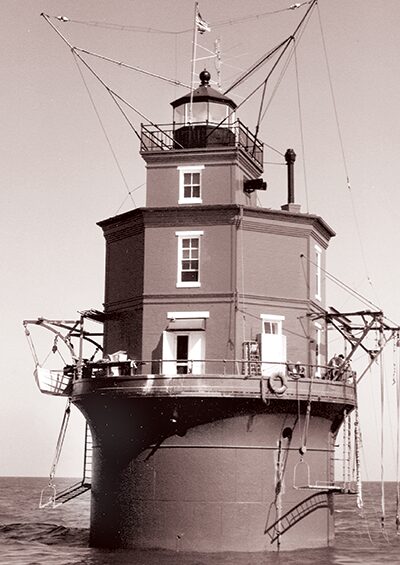
Cucé plans to be an example of living off the grid. He is designing a device that will harness the up and down motion of waves to generate electricity. “Some of the things that people say can’t be done, can be done.”
Solar power, whole house batteries, a sink, temporary shower, and bathroom have been installed at Hooper Island Lighthouse, which is a blueprint for the future. Converting bay water to fresh water can be done with a desalination machine and some are priced reasonably, he explained.
“We are just starting at Wolf Trap. It is so nice when we stay there overnight, to be able to watch the sun set out there after a hard day’s work. Honestly, those few moments of peace and serenity make it all seem worthwhile. I dream of the days when the lighthouses are finished and all we do is host visitors, cook local seafood and make educational videos. Maybe then I will learn to fish.”
How was the lighthouse named?
Wolf Trap Lighthouse got its name from an incident in 1691 when the Wolfe, a 350-ton ship of the Royal British Navy, ran aground in the Bay 3-miles from the east side of what would become Mathews County. Local watermen helped unload guns, ammunition and stores from the ship making it lighter until it floated free.
The Wolfe’s captain refused to pay the watermen. According to Lighthousefriends.com, “The Colonial governor held the captain liable and ordered the garnishment of his wages. Ultimately, the ship’s owners settled the captain’s debts, but the affair so angered the watermen that they thereafter referred to the shallow water as Wolf Trap Shoal.”
Wolf Trap Lighthouse was among the very last Chesapeake Bay lighthouses to be operated by a keeper. It was not automated until 1971.
“The ultimate historical ecotourism”
“The vision of The Lighthouse Centers (TLC) is as deep and wide as Chesapeake Bay. In addition to working with educational institutions and historical and environmental groups, TLC wants to be able to host events at the lighthouses,” said Richard Cucé, president of TLC. “Imagine a sunset champagne toast, fresh seafood dinner, while surrounded by nature and getting the feeling of what it was like to be a lighthouse keeper living out there 150 years ago. It’s the ultimate historical ecotourism!”
TLC will have oysters growing in cages. “We will be able to pull out of the water and show people how oyster farming is done and how important oysters are to the health of the Chesapeake Bay,” Cucé said.
A local university wants to install a weather station at Hooper Island Lighthouse that will feed information to the National Weather Service and NOAA.
“We are giving these historic forgotten lighthouses a new purpose! And we will produce educational videos for everyone to see and learn. Our YouTube channel has a lot of humor so it attracts a younger generation that wouldn’t normally watch videos about the environment or historical lighthouses. These are things that get me excited and keep me motivated during the tough times, which are right now.”
“Ah-ha” moments are motivating
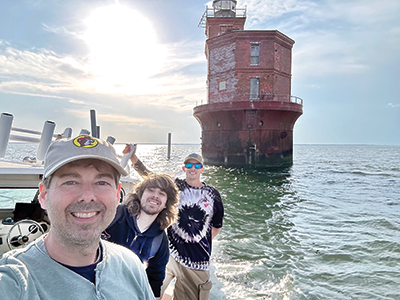
Asked if he had an “ah-ha” moment, Cucé said he had two. “One was when we were featured in the Washington Post and I started getting emails from people around the world wishing me luck and offering support. At the time, I only had one lighthouse. That’s when I knew that I was starting something bigger than myself, so I decided to try to do more than one lighthouse, and that is how TLC started.
“The second moment was when one of our videos went viral on YouTube and I realized that people were enjoying our content. I realized that we might be able to fund a portion of the project by producing entertaining and educational videos that people all over the world enjoy watching. We now have over 30 videos on our channel, over 100,000 subscribers and almost 6 million total views! The response is overwhelmingly positive and supportive!
“We hope to get some large donations and corporate sponsors. It’s hard. But in addition to donations, we say we are trying to get YouTube to pay for the restorations. It’s really neat how it works. Advertising dollars used to be just for big companies, but the way YouTube is set up, anyone can make money by working hard, producing good videos and getting views. We have so many ideas for new videos.
“I’m starting to think I can leave my sandblasting business and go full time into making videos for our channel, which is really scary. I already spent my life savings on the lighthouses, but to also give up the way I’ve always made a living is terrifying to me.
“I’ve always been a person that worked a day and got a dollar that I saved or spent wisely. It’s crazy to think that these videos are out there earning money all over the world and, although it’s not much now, if we keep working hard, it could eventually fund the organization! We hope to save even more than these three lighthouses and grow our network! That’s my dream.”
